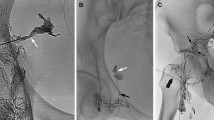Abstract
Purpose
Postoperative lymphatic leakage following thyroid surgery represents a management problem with considerate potential morbidity, psychological, and economical impact. Conservative and surgical management strategies for high- and low-output lymph fistulas are inconsistent. Reliable criteria to predict outcome of conservative versus surgical treatment in clinically evident lymph fistula are lacking.
Material and methods
A retrospective single-center chart review of consecutively quality-control-documented thyroid surgeries from January 1998 to December 2009 was performed to identify reported postoperative lymph fistulas. Documentation of surgical procedures, drainage, medical, and nutritional management was analyzed to identify risk factors for occurrence and criteria for management of evident lymph fistulas.
Results
There were 29 patients identified with postoperative clinical evidence of lymph fistulas following thyroid surgery; incidence was 0.5%. Indication to surgery comprised benign nodular goiter, recurrent nodular goiter, and thyroid carcinoma or local and lymphonodal carcinoma recurrences. There were 12 (41%) primary and 17 (59%) redo surgeries performed. Surgical procedures performed included thyroidectomy, completion thyroidectomy, and primary and redo central and lateral systematic microdissection of lymphatic compartments. All patients were initially submitted to fasting diet and medical treatment, successfully in 19 (66%), whereas ten (34%) patients underwent surgical intervention for fistula closure after failure of conservative treatment. Complications were one wound infection and fistula recurrence in five (26%) patients in the conservative group and two (20%) in the surgical group. Hospital stay was exceedingly prolonged in both groups with a median of 21 and 11 versus 6 days in patients with regular postoperative course following thyroid surgery.
Conclusions
Data of this series support definition of the two categories of high- and low-output fistulas according to drainage collection with >300 versus <200 ml/day. Fasting in low-output fistula facilitates conservative treatment with closed drainage, whereas in high-output fistulas surgical intervention should be sought. Attendant criteria for treatment stratification are equally important, like patient’s compliance, nutritional, and general health status as well as evidence for wound infection. Surgical closure of lymph fistula may be demanding when identification of the secreting fistula is limited and even muscle flap fortification may fail. Ultimately, in unsuccessfully reoperated fistula recurrences, open drainage may become necessary. Lymph fistulas cause significantly prolonged hospital stay, possible critical clinical decay, and unfavorable cosmetic and oncologic outcome while the superior management remains to be defined.

Similar content being viewed by others
References
Roh J, Kim D, Park (2008) Prospective identification of chyle leakage in patients undergoing neck dissection for metastatic thyroid cancer. Ann Surg Oncol 15:424–429
Crumley R, Smith J (1976) Postoperative chylous fistula prevention and management. Laryngoscope 86:804–813
Fitz-Hugh G, Cowgill R (1970) Chylous fistula-complication of neck dissection. Arch Otolaryngol 91:543–547
Spiro J, Spiro R, Strong E (1990) The management of chyle fistula. Laryngoscope 100:771–774
Rodgers G, Johnson J, Petruzzelli G et al (1992) Lipid and volume analysis of neck drainage in patients undergoing neck dissection. Am J Otolaryngol 13:306–309
Kinnaert P (1973) Anatomical variations of the cervical portion of the thoracic duct in man. J Anat 115:45–52
Gottlieb M, Greenfield J (1956) Variations in the terminal portion of the human thoracic duct. Arch Surg 73:955–959
Jimenez P, Guirao M, Blanco R et al (2008) Chyle fistula in right cervical area after thyroid surgery. Clin Transl Oncol 10:593–596
Nussenbaum B, Liu J, Sinard R (2000) Systematic management of chyle fistula: the Southwestern experience and review of the literature. Otolaryngol Head Neck Surg 122:31–38
Bozzetti F, Arullani A, Baticci F et al (1982) Management of lymphatic fistulas by total parenteral nutrition. J Parenter Enteral Nutr 6:526–527
Hashim S, Roholt H, Babayan V et al (1964) Treatment of chyluria and chylothorax with medium chain triglyceride. New Engl J Med 270:756–761
Ramos W, Fainjtuch J (1986) Nutritional management of thoracic duct fistulas. A comparative study of parenteral versus enteral nutrition. J Parenter Enteral Nutr 10:519–521
Boschin M, Toniato A, Pagetta C et al (2006) Cervical lymphorrea after nodal dissection: role of fasting based on clinical evidence. Minerva Chir 61:57–62
Thawley S (1980) Chylous fistula prevention and management. Laryngoscope 90:522–525
Tilney N, Murray J (1968) Chronic thoracic duct fistula: operative technique and physiologic effects in man. Ann Surg 167:1–8
Fabian R (2003) Neck dissection: technique. In: Randolph G (ed) Surgery of the thyroid and parathyroid glands. Saunders, Philadelphia, pp 428–429
Bergamaschi R, Becouarn G, Ronceray J et al (1998) Morbidity of thyroid surgery. Am J Surg 176:71–75
Erisen L, Coskun H, Basut O (2002) Objective and early diagnosis of chylous fistula in the postoperative period. Otolaryngol Head Neck Surg 126:172–175
Myers E, Dinerman W (1975) Management of chylous fistulas. Laryngoscope 85:835–840
Dralle H, Machens A (2008) Surgical approaches in thyroid cancer and lymph-node metastases. Best Pract Res Clin Endocrinol Metab 22:971–998
Slaughter D, Southwick H (1955) Cervical thoracic duct fistulas. Ann Surg 142:307–310
Har-El G, Segal K, Sidi J (1985) Bilateral chylothorax complicating radical neck dissection: report of a case with no concurrent external chylous leakage. Head Neck Surg 7:225–230
Nutz V, Lie T (1982) Chyle fistula following surgery of the thyroid gland. A rare complication. Chirurg 53:655–657
De Gier H, Balm A, Bruning P et al (1996) Systematic approach to the treatment of chylous leakage after neck dissection. Head Neck 18:347–351
Kassel R, Havas T, Gullane P (1987) The use of topical tetracycline in the management of persistent chylous fistula. J Otolaryngol 16:174–178
Kirse D, Stern S (1997) Phrenic nerve paralysis after doxycycline sclerotherapy for chylous fistula. Otolaryngol Head Neck Surg 116:680–683
Valentine C, Barresi R, Prinz R (2002) Somatostatin analog treatment of a cervical thyrocoracic duct fistula. Head Neck 24:810–813
Author information
Authors and Affiliations
Corresponding author
Rights and permissions
About this article
Cite this article
Lorenz, K., Abuazab, M., Sekulla, C. et al. Management of lymph fistulas in thyroid surgery. Langenbecks Arch Surg 395, 911–917 (2010). https://doi.org/10.1007/s00423-010-0686-2
Received:
Accepted:
Published:
Issue Date:
DOI: https://doi.org/10.1007/s00423-010-0686-2




